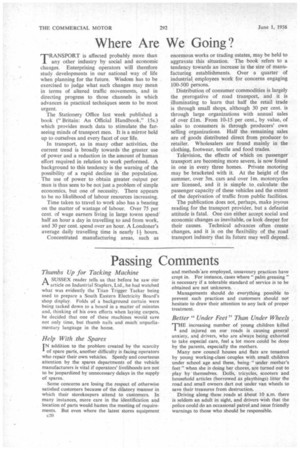Where Are We Going?
Page 70

If you've noticed an error in this article please click here to report it so we can fix it.
rTRANSPORT is affected probably more than any other industry by social and economic changes. Enterprising operators will therefore study developments in our national way of life when planning for the future. Wisdom has to be exercised to judge what such changes may mean in terms of altered traffic movements, and in directing progress to those channels in which advances in practical techniques seem to be most urgent.
The Stationery Office last week published a book (" Britain: An Official Handbook," I5s.) which provides much data to stimulate the farseeing minds of transport men. It is a mirror held up to ourselves and every facet of our life.
In transport, as in many other activities, the current trend is broadly towards the greater use of power and a reduction in the amount of human effort required in relation to work performed. A background to this tendency is the warning of the possibility of a rapid decline in the population. The use of power to obtain greater output per man is thus seen to be not just a problem of simple economics, but one of necessity. There appears to be no likelihood of labour resources increasing.
Time taken to travel to work also has a bearing on the matter of wastage of labour. Over 75 per cent. of wage earners living in large towns spend' half an hour a day in travelling to and from work, and 30 per cent. spend over an hour. A Londoner's average daily travelling time is nearly 11 hours.
Concentrated manufacturing areas, such as enormous works or trading estates, may be held to aggravate this situation. The book refers to a tendency towards an increase in the size of manufacturing establishments. Over a quarter of industrial employees work for concerns engaging 100-500 persons.
Distribution of consumer commodities is largely the prerogative of road transport, and it is illuminating to learn that half the retail trade is through small shops, although 30 per cent. is through large organizations with annual sales of over Lim. From 10-15 per cent., by value, of sales to consumers is through producers' own selling organizations. Half the remaining sales are of goods distributed direct from producer to retailer. Wholesalers are found mainly in the clothing, footwear, textile and food trades.
Television, the effects of which on passenger transport are becoming more severe, is now found in one in every three homes. Private motoring may be bracketed with it. At the height of the summer, over 3m. cars and over 1 m. motorcycles are licensed, and it is simple to calculate the passenger capacity of these vehicles and the extent of the deprivation of traffic from public facilities.
The publication does not, perhaps, make joyous reading for the transport provider, but a defeatist attitude is fatal. One can either accept social and economic changes as inevitable, os look deeper for their causes. Technical advances often create changes, and it is on the flexibility of the road transport industry that its future may well depend.




























































































































































































































































